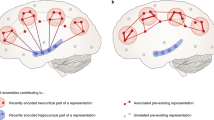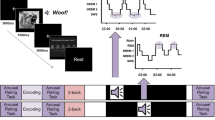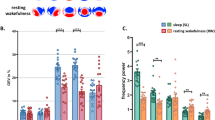Abstract
SOME theorists have ignored the content of dreams and concentrated specifically on chemical or physiological aspects1. Oswald2 has postulated that rapid eye movement (REM)3 sleep is a non-specific indication of many forms of synthesis within cerebral neurones, and that periods of massive learning would cause high percentages of REM sleep. Others have explained both dream content and REM state as playing a part in information processing. Some have used computer analogies, suggesting that reorganization takes place during the REM state, involving revision arid updating of cognitive processes and memories4. It is known that remembering involves distortion and conventionalization5, so REM-induced reorganization should also show “effort after meaning”.
This is a preview of subscription content, access via your institution
Access options
Subscribe to this journal
Receive 51 print issues and online access
$199.00 per year
only $3.90 per issue
Buy this article
- Purchase on Springer Link
- Instant access to full article PDF
Prices may be subject to local taxes which are calculated during checkout
Similar content being viewed by others
References
Dement, W., Amer. J. Psychiat., 122, 404 (1965); Snyder, F., ibid., 123, 121 (1966); Jouvet, M., Science, 163, 32 (1969).
Oswald, I., Nature, 223, 893 (1969).
Dement, W., and Kleitman, N., Electroenceph. Clin. Neurophys., 9, 673 (1957).
Newman, E. A., and Evans, C. P., Nature, 206, 534 (1965); Gaarder, K., Arch. Gen. Psych., 14, 253 (1966); Hawkins, D. R., Brit. J. Med. Psychol., 39, 85 (1966); Dewan, E. M., Psychophysiology, 4, 365 (1967); ibid., 5, 203 (1968).
Bartlett, F. C., Remembering (Cambridge University Press, 1932).
Jenkins, J. C., and Dallenbach, K. M., Amer. J. Psychol., 35, 605 (1924); Van Ormer, E. B., Arch. Psychol., 21, 1 (1932); Newman, E. B., Amer. J. Psychol., 52, 65 (1939); Lovatt, D. J., and Warr, P. B., ibid., 81, 253 (1968).
Rechtschaffen, A., and Kales, A. (eds.), A Manual of Standardised Terminology, Techniques and Scoring System for Sleep Stages of Human Subjects (US Government Printing Office, Washington, DC, 1968).
Clarke, P. R. F., et al., Brit. J. Anaesth. (in the press).
Miller, G. A., Isard, S., J. Verb. Learn. Verb. Behav., 2, 217 (1963).
Horowitz, M. W., and Berkowitz, A., Percept. Mot. Skills, 24, 207 (1967).
Puff, C. R., J. Verb. Learn. Verb Behav., 5, 503 (1966).
Author information
Authors and Affiliations
Rights and permissions
About this article
Cite this article
EMPSON, J., CLARKE, P. Rapid Eye Movements and Remembering. Nature 227, 287–288 (1970). https://doi.org/10.1038/227287a0
Received:
Revised:
Issue Date:
DOI: https://doi.org/10.1038/227287a0
This article is cited by
-
Objective assessment of drowsiness and reaction time during intermittent Ramadan fasting in young men: a case-crossover study
Behavioral and Brain Functions (2013)
-
Association between memory impairment and insomnia among older adults
European Journal of Ageing (2006)
-
Early sleep triggers memory for early visual discrimination skills
Nature Neuroscience (2000)
-
The organization and regulation of sleep
Experientia (1984)
-
EEG patterns and body temperatures in man during sleep in arctic winter nights
International Journal of Biometeorology (1976)
Comments
By submitting a comment you agree to abide by our Terms and Community Guidelines. If you find something abusive or that does not comply with our terms or guidelines please flag it as inappropriate.



